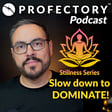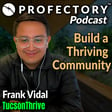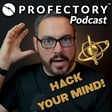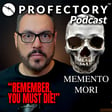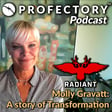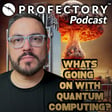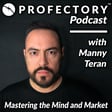Become a Creator today!Start creating today - Share your story with the world!
Start for free
00:00:00
00:00:01

The Stillness Series- Part 3: The Hidden Power Behind Free Flow Thinking
In this third episode of the Stillness Series, we explore the power of free flow thinking and its connection to breakthrough insights in business and life. We explain the difference between focused and diffuse thinking, urging listeners to deliberately create space for mental stillness. Through personal stories, scientific research, and team-based applications, Manny shows how moments of rest can unlock strategic clarity and performance. Stillness isn’t about doing nothing—it’s about preparing the mind for the next powerful move.
Transcript
Introduction to The Profectory Podcast
00:00:04
Speaker
The Profectory Podcast, Mastering the Mind and Market. Hosted by Manny Turan, we explore what it takes to succeed both in business and within yourself.
Strategies for Growth and Resilience
00:00:15
Speaker
From a strategy and business growth to mindset and resilience, we provide the tools to lead with clarity, confidence, and wisdom.
00:00:32
Speaker
Welcome to the Profectory Podcast, Mastering the Mind and Market. My name is Manny Turan and I'm your host. On the Perfectory podcast, we give you tools and insights in order for you to crush it in business, crush it in life by looking at the world in a different perspective.
00:00:52
Speaker
We use lots of stoic philosophy tools, but we also use a lot of science and ah blend of my personal experience.
The Stillness Series Introduction
00:01:00
Speaker
We're bringing in some conversations with entrepreneurs and business leaders who have been there, done that as well.
00:01:06
Speaker
And we are creating this small series called Stillness Series in which we are exploring the power of stillness in order to prepare and propel you in business and in life.
00:01:18
Speaker
And in the first and second part, we talked about stillness as a concept. The second one, we talked about nature as a catalyst. And on today's podcast, we're talking about free flow thoughts and strategic breakthroughs.
Exploring Brain's Thinking Modes
00:01:33
Speaker
This idea of free flow thoughts is something that I've been exploring for a while. Now, the brain has two ways of thinking, and you're actually familiar with both of them.
00:01:44
Speaker
Perhaps you didn't know they had a name. The first of which is focus thinking. You're focused on something, you're writing something, you're on your phone, you're on an in a conversation, and you're directing all of your attention towards a particular subject.
00:01:58
Speaker
The other one is diffuse thinking. That means you're driving to work and an idea pops in your head or you're in the shower or you're sort of watching a movie but not really watching it. You're sort of out there and then something pops in your mind.
00:02:12
Speaker
This diffused thinking has a lot of power. And that is something that I'm gonna talk about today in today's podcast is the idea of the power of this free flow thinking which is side by side with diffuse thinking. Basically, it's the same thing.
00:02:28
Speaker
The only thing that's different between the diffuse thinking and the side by and the um free flow of thinking that I just mentioned is free flow thinking, I'm gonna invite you to create time for this sort of thing.
00:02:41
Speaker
A lot of my ideas that I've had breakthrough ideas, have happened in the space between activities. Or I'm driving to work, or um I'm maybe taking a hike, or I'm just sitting there and waiting for my flight to land or something.
00:02:58
Speaker
And these moments of stillness, whether even even if it's in the middle of a crowd, these moments between activities are is when this free flow thinking sort of takes place. What I'm inviting you to do is is actually create space to do this in your own practice, whether that's in the morning, you're getting ready, you brush your teeth, you shower, whatever.
00:03:18
Speaker
If you create five or 10 minutes to just sit there on your couch, somewhat awkwardly, i may i may add, because you're not doing anything. And I mentioned earlier, our brains are so accustomed to being on our phones, to being completely bombarded and and ah your attention being sucked out of you all the time, that if you are able to sit for five minutes, sit on your hands even if you have to, and just sit there and let your thoughts unfold.
00:03:48
Speaker
Now, what I've done is for...
Practices for Capturing Ideas
00:03:51
Speaker
actually more than half my life, I've kept these moleskin books around me and I've got a whole box of them in the other room there.
00:04:00
Speaker
and The idea with these books is they're my central note-taking um resource. I take notes on them. i take They're like a journal of sorts. And oftentimes, if if I'm struggling with something and and i don't know how to resolve it, one of the tools I use is just to sit there and in quiet, like I mentioned, for five or 10 minutes, have my Moleskine notebook next to me, breathe and wait.
00:04:30
Speaker
And it isn't always hurrah kind of moments where you're you're hearing a marching band coming down with the idea. But it's it's a little tiny moments of almost like flakes of gold if you're gold painting.
00:04:45
Speaker
Little flakes of gold of thoughts of an idea that you can jot down that then will coalesce and build upon each other over time to give you that breakthrough technology, breakthrough idea, breakthrough conversation, whatever you're actually struggling with.
Meditation and Mindfulness Resources
00:05:01
Speaker
And this stillness is is so difficult. This cultivation of your you have your breakthrough um or your free flow of thought is so difficult. It sounds easy. It sounds awkward. sounds weird just sitting there thinking about nothing.
00:05:15
Speaker
But I'm telling you, there's power to it. Stillness within ourselves is is always hard to grasp because of this. Our mind is everywhere.
00:05:28
Speaker
And I didn't go too much into meditation in this particular series. I might mention it in the closing thoughts. But meditation is also a very powerful tool. I'm not going to purport to be an expert in meditation. You can go to YouTube and find a multitude of people that'll walk you through meditation. There's Insight Timer and other apps out there you can leverage for meditation.
00:05:52
Speaker
But meditation as a tool of stillness is also very powerful. They're actually one and the same, but in almost like different flavors. Let me give you some ah some context from the science side of why these free flow breakthrough concepts are so important, this ah diffuse mode thinking.
00:06:14
Speaker
This is from the Harvard Business Review, which incidentally, as a business leader, as ah somebody who is a entrepreneur looking to make big moves in life,
00:06:27
Speaker
A subscription to Harvard Business Review is invaluable. I've had one for a decade. Very powerful, actually more than that. Very powerful journal. And it's not that expensive if you think about the the nuggets and actually the, not even flakes of gold, the nuggets of ideas you get from from the Harvard Business Review website.
00:06:47
Speaker
Highly they suggest you do it. The online version's good, but I prefer the old school magazine that I can flip through and make notes on if I have to or share. Something just to keep in mind. But back to the idea.
Free Flow Thinking and Subconscious
00:07:01
Speaker
Harvard Business Review and psychologist Jonathan Schooler said that mind-wandering or free-flow thought can lead to insight-based problem-solving.
00:07:14
Speaker
It's when the braid subconsciously connects unrelated ideas, often while at rest. So that is a very powerful idea. And the takeaway is that free flow time is not wasted time.
00:07:29
Speaker
That's when your brain incubates these high potential ideas. It's when your subconscious, we mentioned this before, your conscious is this tiny thing on top and the subconscious is this giant iceberg underneath our awareness.
00:07:43
Speaker
That has a lot of power. There's like an engine down there that's humming and churning and all that. By being able to, to, be still by being able to cultivate free flow thinking, diffuse thinking, you're harnessing the power of that engine below the surface so that the ideas will bubble up and give you some breakthroughs.
Stillness in Strategic Thinking
00:08:09
Speaker
I always say, and I've said for a long time, that business as in life is a full contact sport. In business, you're not pussyfooting around and you're not waiting for this, waiting for that, waiting for market conditions to be perfect.
00:08:26
Speaker
If you want to be successful in business, you are hard driving. You are out there. You're getting hurt. You're you're putting your name out. You're getting bruised and you're creating a lot of ruckus, a lot of momentum.
00:08:38
Speaker
And that's there's power to that. Stillness is the rest. Stillness is the breath. Stillness is the power that you need so that when you're you're actually in, you're sparring, if you will, when you're sparring in business, the idea of free flow thinking, of diffuse thinking is where will you place that next punch?
00:09:00
Speaker
Massive power in being able to just just calm your brain for a minute, let these ideas percolate so that you can make these decisions and keep on moving. My grandmother, who's a huge mentor of mine, is like she her mantra is, keep moving, mijo.
00:09:15
Speaker
If you are down, if you're having issues, keep moving. I completely agree with my Nana, of course, but I would also say that in in addition to keep moving, you also need to rest.
00:09:30
Speaker
need to rest so that you keep on moving. There's a difference between just being lazy and not moving at all, and that's not exactly stillness. What I mean by stillness, what I've meant here in this series so far is is creating this space within your own head so that ideas, so that you're able to garner that energy, the ideas, the momentum, and make um the the right moves in your business and in life.
00:09:57
Speaker
Life also, I always say, is not, if you were to want to make impact, you play chess, not checkers. That's how it is. And there's another um thing I'll share with you regarding some science.
Mindfulness Programs and Productivity
00:10:13
Speaker
This is mindfulness and meditation drive performance and resilience. The source is Google's Search Inside Yourself program, SAP Aetna case studies.
00:10:23
Speaker
And the results are that Aetna, which is a massive insurance company, reported saving $3,000 per employee per year. per employee per year in productivity gains from mindfulness programs.
00:10:37
Speaker
And SAP saw a 200% ROI from investing in mindfulness training. The takeaway is inner stillness is an economic multiplier of success and prosperity.
00:10:53
Speaker
Cultivate however you can this idea of stillness. Look at ways that you can do this and apply it to your own life. And in the next mini-podcast here, we're gonna look at specific things you can do as practical tools for reconnecting with your yourself, with your stillness.
00:11:14
Speaker
And I'll give you a couple more stories here before we conclude today's podcast. ah The idea of free flow thinking can also be and be ah be harnessed by several people together.
00:11:29
Speaker
This is what I mean. If you are challenged with a big issue, if you have a team of people that are challenged with a big issue, and you don't have an answer, you don't know if you're gonna go this direction or that direction, and if you give your team members the framework of this is what we're dealing with, I want you to go home and sit down for 10, 15 minutes, or maybe before you go home in your office, spend time really thinking about it, not on your phone, not on your computer, just think about it, and write down any ideas you might have.
00:12:09
Speaker
and let's come back tomorrow and share them. What you understand is if you ask your team to do this, I would say about 20% of them we'll will have nothing to share.
00:12:20
Speaker
they'll They'll basically have, well, I did it, i didn't really have anything to share. And you'll have about, 60% of them that will come back with cool ideas that have some really interesting implications.
00:12:36
Speaker
And then the final 20% will come back with gold. And that gold collected together will give you a good um push towards the answer that you're looking for.
Real-life Applications of Free Flow Thinking
00:12:48
Speaker
I've used a a similar version of this in my team when I was running my company several years ago, not my current one, not the current one I'm running, but another one. And the idea is that we were contemplating buying a building.
00:13:03
Speaker
And I was, and I still struggle with this, I tend to be somewhat impulsive. And I tend to be very, i I see something I want and I just latch on. And for better for worse, that's been my success story, but I always, and at least now in my as I'm advancing in my career, as I'm advancing with building a more strategic team around me, and through that process, I ask my team to do something similar.
00:13:29
Speaker
Go back to your office and let's come back tomorrow. Give me some of the the top five reasons why we should and top reasons why we should not move into this building.
00:13:41
Speaker
And i I put a framework together, meaning I wanted them to go go back to their places, cultivate this, come back. When we came back, we had this massive list.
00:13:52
Speaker
A lot of things were similar of why we wanted to get the building. We needed more space. We didn't have enough power in our in our shop at the time. There's a lot of reasons that are very practical.
00:14:02
Speaker
But what was interesting in were the reasons why we shouldn't. And cultivating the space and that free flow thinking led to some interesting concepts that ended up changing the way we did things in the new building.
00:14:17
Speaker
Let me give you an example that I remember is there was ah an idea that the culture would be much different. We were moving from a 3,500 square foot building where the shop and the offices were all together in one big area. There weren't that much separation.
00:14:36
Speaker
To a massive, I think it was 18,000 square foot building where there was like a 10,000 square foot shop. And then it was upstairs and downstairs. And there was another shop. It was just way different.
00:14:47
Speaker
And the idea was, hey listen, we're going to lose our culture. Things are going to change. We're not bumping into the same people in the hallway all the time. Now we're having to go to different places. And that led to the ah the fact that we really had to be cognizant about spending time on a regular basis, doing barbecues, doing events.
00:15:09
Speaker
We actually organized the break room in a way that made it um sort of central so that people would cultivate and come to the middle from all aspects of the building, whether it was a machine shop, or the engineers upstairs, they would all have to come together in this area. And that was that came from that free flow of thinking.
00:15:26
Speaker
And there was other things on that list that were, we'll say, more practical about how we laid things out. But that came from the idea of of taking that concept to your team.
Philosophical Insights on Thoughts and Calm
00:15:39
Speaker
And it's hard in in today's age, especially with so much social media, that people have a tendency to think that things like this are very much a flash in the pan.
00:15:50
Speaker
and they they come and go these concepts, but they don't. This concept that I'm referencing is a Stoic concept. And I mentioned some Marcus Aurelius and the idea of of a Seneca. there Here's ah a great quote by Marcus Aurelius.
00:16:08
Speaker
The soul becomes dyed with the color of its thoughts. Brilliant. What that means is if you are constant in constant, in a constant frenzy and you have no stillness in your life, your soul is is painted with those colors.
00:16:25
Speaker
But if you're calm, collected, if you cultivate your free form thinking, if you practice mindfulness, if you come to your team and um take these ideas to them as well, then you cultivate calm and you cultivate that color in your soul.
Conclusion and Invitation to Integrate Stillness
00:16:43
Speaker
You've all met people that, on both sides actually, some people that you meet, your energy, or you're their energy towards you, or whatever, however you wanna describe it, just creates a lot of frenzy in your in your body. like you They make you uncomfortable.
00:17:03
Speaker
And they make you, whether it's the way they're talking, the way they're dressed, the way they, their mannerisms, whatever it is, they make you uncomfortable. And then there's other people that you meet with and they just calm you down.
00:17:14
Speaker
There's, they calm you down. That concept that I'm describing to you is that cultivation from inside the stillness. So I invite you to to look at these things, spend time on the first two episodes if you haven't listened to them yet, put this all together in the Stillness series.
00:17:33
Speaker
In the next um couple, actually the the last one is about practical tools for reconnection. And we're gonna sum up some of the general concepts here and that we're excited to share with these thoughts with you very soon.
00:17:47
Speaker
Thank you.

